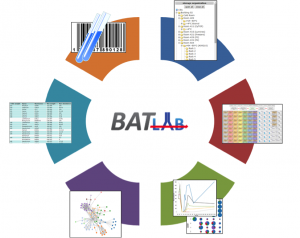Technologies
Bioinformatics
Bioinformatics – data integration
The Bioinformatics core develops innovative solutions for data integration and analysis.
Developed since 2012, BATLab is a web-based Laboratory Information Management System (LIMS). It is designed to store, integrate and visualize heterogeneous data. Allowing precise and complex credentials support, a large kind of information can be stored from metadata to biological analyzes and storage management. It comes generally with the commercial software Tableau (commercialized in France by Mydral) in order to visualize and analyze your data in an integrated way. Tableau also provides the ability to take a snapshot of your data from the database, for example when you begin to write a paper or when you travel with your laptop without network access.
BATLab top features
- Web-based interface
- Mass-Cytometry instrument (CyTOF) Quality Control management
- Plate schemes creation
- Barcodes handling (connection with scanners and printers)
- Biological Resource Center
- Storage manager
- Biological results (Cytometry, Multiplex, CBC, Viral load, Interventions …)
- Modules for antibodies, consumables …
BATLAB © 2012-2015. CEA: DSV/IMETI/SIV
Conceived by Brice TARGAT and Antonio COSMA, designed and developed by Brice TARGAT.
PRESS RELEASE
Tableau speaks about FlowCyTech (CEA)
Bioinformatics – systems biology
The Bioinformatics core performs complex multidimensional analyzes of genomic, transcriptomic and cytometry data collected in our lab. Using our data analysis expertize, we aim to identify and predict the most important biological components involved in viral studies or in vaccine stimulations. As part of several scientific collaborations, we are working on the reconstruction of highly homologous genes, on the modeling of transcriptomic kinetics processes, and on the analysis of large mass cytometry profiles.
Bioinformatics – computational biology
The Bioinformatics core is also involved in the development of new analysis methods and algorithms. These new methods aim to better identify relevant biological components and to visualize complex data collected in our lab. We are currently developing R/bioconductor packages and web-based solutions to analyze mass-cytometry data, obtained from SPADE (Spanning-tree Progression Analysis of Density-normalized Events) or viSNE results. We are also developing our own automatic annotation system for cytometry profiles.




